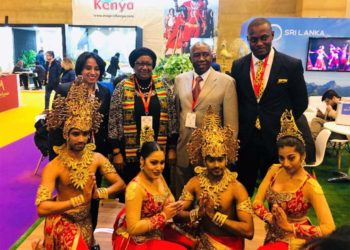Sri Lanka’s Culture, Styled by Amilani

In this exclusive interview for CeylonDigest, we celebrate
the remarkable journey of Amilani Perera, a visionary Sri
Lankan fashion designer whose work is deeply rooted in
the island’s rich cultural heritage. Since launching her
luxury brand in 2013, Amilani has showcased Sri Lanka’s
unique artistry on international stages from Colombo to
New York, blending tradition with modern elegance while empowering women survivors of violence through
meaningful partnerships.
With a background spanning Sri Lanka, Singapore, India,
and Australia, Amilani’s designs tell powerful stories—from
ancient queens to contemporary digital age themes—
woven through handloom fabrics crafted by survivors,
inspired by Sri Lanka’s history and folklore. Her work is a
testament to how fashion can preserve culture, support
sustainable tourism, and empower communities.
We sat down with Amilani to discuss the synergy of
tourism, heritage, fashion, and family support in Sri Lanka’s cultural renaissance.
Interview Questions: Exploring Tourism, Culture &
Heritage
Q1: How does Sri Lanka’s rich cultural heritage influence
your creative process and design choices?
Amilani: Amilani Perera’s creative process and design
choices are deeply influenced by Sri Lanka’s rich cultural
heritage. This influence is evident in her brand’s exotic
luxury aesthetic, which blends traditional craftsmanship
with contemporary fashion. Her collections often
incorporate locally inspired motifs, textiles, and artisanal
techniques, celebrating the beauty and depth of Sri
Lankan culture while appealing to an international
audience. This fusion of heritage and modernity helps her
create unique, high-quality garments that tell meaningful
stories.
Q2: How can fashion help preserve and promote Sri
Lankan culture locally and internationally?
Amilani: Fashion holds tremendous potential to both preserve and
promote Sri Lankan culture on local and internationalstages. Designers like Amilani Perera play a crucial role in this cultural stewardship by weaving traditiona craftsmanship and storytelling into contemporary fashion, ensuring that Sri Lanka’s rich heritage remains vibrant and relevant today.
One of the most significant ways fashion contributes is by
showcasing traditional craftsmanship. By incorporating
indigenous techniques, such as handloom weaving,
intricate embroidery, and heritage-inspired designs,
fashion acts as a living archive of centuries-old artisanal
knowledge. This not only preserves the skills passed down
through generations but also introduces them to new
audiences, both within Sri Lanka and abroad.
Fashion also serves as a powerful medium for storytelling
through design. Collections inspired by Sri Lankan history,
folklore, and natural landscapes invite international
audiences to engage with the island’s unique cultural
identity. Each garment becomes a narrative piece that
communicates deeper cultural meanings, fostering a
connection between wearer and heritage.
Moreover, fashion empowers local communities by
providing sustainable livelihoods to artisans, weavers, and
craftsmen. This economic support ensures that traditional
practices continue to thrive, preventing these valuable
skills from fading away in the face of modernization. By
prioritizing ethical collaborations, designers help preserve
cultural knowledge while uplifting vulnerable
communities.
Global platforms further amplify the impact of Sri Lankan
fashion. Events such as Colombo Fashion Week, Asian
Designer Week, and the Ultra Luxe Fashion Show in
Singapore showcase Sri Lankan-inspired collections to
international buyers, media, and consumers, bringing
well-deserved attention to the island’s creative industries.
These opportunities not only elevate the profile of Sri
Lankan culture but also open doors for cultural exchange
and tourism.
Lastly, the promotion of sustainable and ethical fashion
practices, rooted in traditional methods, reinforces
cultural preservation while addressing environmental
concerns. This commitment aligns heritage with
contemporary global values, making Sri Lankan fashion a
model for both cultural and ecological responsibility.
Through these multifaceted avenues, fashion becomes
more than just apparel—it transforms into a vibrant
cultural ambassador. It fosters pride within Sri Lanka and
cultivates appreciation and respect for the country’s heritage on the world stage, ensuring that the beauty and
depth of Sri Lankan culture continue to inspire and endure.
Q3: How does your brand contribute to Sri Lanka’s cultural
image abroad?
Amilani: Amilani Perera’s fashion brand plays a significant
role in shaping and elevating Sri Lanka’s cultural image on
the international stage. As a designer who remains deeply
connected to her roots, Amilani uses her brand as a
medium to reflect the island’s rich heritage, values, and
artistic expression through fashion. Her collections are not
just garments; they are narratives inspired by the textures,
traditions, and spirit of Sri Lanka. By integrating locally
inspired design elements, natural motifs, and artisanal
techniques into her ready-to-wear pieces, Amilani brings a
sense of Sri Lankan identity to global fashion audiences.
The brand’s active participation in major international
fashion events—such as Asian Designer Week in New
Delhi, USA-Sri Lanka Fashion Week in New York, and the
Ultra Luxe Fashion Show in Singapore—serves as a
platform for cultural diplomacy. These events allow her to
present uniquely Sri Lankan designs to a broader audience,positioning the country as a source of exotic luxury and sophisticated creativity. Amilani’s consistent representation of Sri Lanka on global runways helps reinforce the image of the nation as a hub for innovative
and meaningful fashion. Beyond aesthetics, the brand also contributes to thecountry’s cultural image through social advocacy. In collaboration with the United Nations Population Fund (UNFPA), Amilani Perera empowers survivors of gender- based violence in Sri Lanka by involving them in the design
and production processes. This initiative showcases the
compassionate and resilient spirit of the Sri Lankan
people, highlighting how fashion can be used as a tool for
healing and empowerment. It presents Sri Lanka not only
as a place of beauty and heritage but also as a society
striving for positive change and gender equity.
Moreover, Amilani Perera serves as the official designer
for the Airport & Aviation Services of Sri Lanka, a role that
allows her to design uniforms that are often the first
impression international visitors have of the country. This
responsibility further cements her brand’s role in shaping Sri Lanka’s identity through refined and elegant visual representation.
In essence, Amilani Perera’s brand acts as a cultural
ambassador for Sri Lanka. Through her artistic vision,
social commitment, and global presence, she contributes
to a modern and progressive image of her homeland—one
that respects tradition, embraces innovation, and stands
proudly on the world stage.
Q4: What cultural stories do you want international
audiences to connect with through your designs?
Amilani: What cultural stories do you want international
audiences to connect with through your designs?
Through her fashion brand, Amilani Perera seeks to share
deeply rooted cultural stories that reflect the soul of Sri
Lanka. Her designs are more than just visual art—they are
narratives that capture the essence of Sri Lankan heritage,
resilience, and humanity. One of the core stories she
wishes international audiences to connect with is the
strength and grace of Sri Lankan women, particularly
those who have faced adversity and emerged empowered.
By engaging survivors of gender-based violence in the
design process, Amilani gives voice to their untold stories,
turning their journey of healing into a symbol of courage
and beauty woven into each garment.
Amilani also aims to highlight Sri Lanka’s rich artisanal
legacy, from traditional textile techniques like handloom
weaving to ancient embroidery methods. These cultural
crafts carry generations of history and are often created
by rural artisans whose skills have been passed down
through families. By integrating these into modern
silhouettes and luxury fashion, Amilani ensures that
international audiences recognize and value the
craftsmanship and cultural significance behind each piece.
This fusion of old and new allows the world to see Sri
Lanka not as a relic of the past, but as a vibrant, evolving
culture with deep roots and global relevance.
Nature, spirituality, and storytelling also play an important
role in her design ethos. Elements drawn from Sri Lanka’s
natural landscapes—its lush forests, oceanic blues, and
tropical flora—find their way into the colour palettes,
textures, and patterns of her collections. These design
choices create a connection between wearer and place,
allowing international audiences to experience the island’s
natural beauty and serenity through fashion.
Ultimately, Amilani Perera’s goal is to communicate the
values of resilience, authenticity, and cultural pride
through her clothing. She invites the world to look beyond
the fabric—to see the lives, traditions, and stories that
bring each garment to life. By doing so, she helps bridge
cultures and foster understanding, reminding global
audiences that fashion is not only about style, but about
storytelling and shared humanity.
Q5: How important is storytelling in your designs for
keeping heritage alive?
Amilani: For Amilani Perera, storytelling is not just a
creative choice—it is a fundamental part of her design
philosophy and a powerful tool for preserving Sri Lanka’s
cultural heritage. In a rapidly globalizing world where
fashion trends can often feel homogenized, storytelling
allows her to root her collections in something deeply
personal, meaningful, and enduring. Through every
silhouette, fabric, and embellishment, Amilani breathes
life into narratives that speak of Sri Lanka’s history,
traditions, and human spirit.
Storytelling in fashion serves as a bridge between the past
and the present. By embedding cultural references,
traditional motifs, and handcrafted elements into her
modern, ready-to-wear pieces, Amilani ensures that the
essence of Sri Lankan heritage is carried forward in a way
that is both relevant and respectful. This practice not only
honors the artisans and customs of the past but also
introduces them to new generations and global audiences
who may be unfamiliar with Sri Lanka’s cultural richness.
Moreover, storytelling allows Amilani to highlight the lived
experiences of real people, especially women who have
survived violence and trauma. Through her collaboration
with the United Nations Population Fund (UNFPA), she
incorporates their journeys into the design process—
transforming pain into power, and silence into artistic
expression. These narratives do more than keep heritage
alive; they expand it, making it more inclusive and
reflective of modern-day resilience and transformation.
In this way, fashion becomes a language—one that speaks
across borders and generations. Amilani’s garments are
not just clothes; they are storytellers. They invite wearers
and viewers to explore the rich tapestry of Sri Lanka’s
cultural identity, to feel its textures, understand its
struggles, and celebrate its beauty. By grounding her
collections in stories, Amilani keeps heritage alive not as
something static or nostalgic, but as something evolving—
infused with emotion, history, and hope.
Ultimately, storytelling is central to Amilani Perera’s vision.
It allows her to craft designs with depth and purpose, to
preserve cultural memory, and to inspire a global audience
to see fashion as a meaningful, transformative art form.
Q6: Do you collaborate with local artisans or
communities? How does this affect culture and tourism?
Amilani: Yes, Amilani Perera actively collaborates with
local artisans and communities, making these
partnerships a cornerstone of her brand’s identity and
mission. These collaborations are not only vital to
preserving Sri Lanka’s rich craftsmanship traditions but
also serve as a catalyst for cultural sustainability and
economic empowerment. By integrating the work of local
artisans into her collections, Amilani ensures that
traditional techniques such as handloom weaving, natural
dyeing, and embroidery continue to thrive in the modern
fashion industry. Such collaborations go beyond aesthetics—they are actsof cultural preservation. Many of the artisans involved in
her design process come from rural areas where
generational skills are at risk of disappearing due to
modernization and lack of market access. By providing
these communities with consistent work and global
exposure, Amilani helps revitalize these traditional crafts,
giving artisans both economic stability and a renewed
sense of pride in their heritage.
This community-driven approach also has a positive
impact on cultural tourism. When a fashion brand like
Amilani Perera gains international recognition, it draws
attention to the unique cultural offerings of Sri Lanka.
Tourists and fashion enthusiasts become more curious
about the stories behind the garments—where they are
made, who makes them, and the techniques involved. This
curiosity often translates into a desire to experience these
traditions firsthand, encouraging more people to visit
artisan villages, workshops, and local markets. In this way,
fashion becomes a gateway to experiential cultural
tourism, which can boost local economies and foster
deeper cultural exchange.
Moreover, Amilani’s collaboration with survivors of
gender-based violence—through her partnership with the
United Nations Population Fund (UNFPA)—adds a
profound social layer to her work. By engaging these
women in skill-building and design, the brand not only
empowers individuals but also promotes inclusive cultural
narratives. These efforts show that fashion can uplift
communities and turn traditional practices into tools for
healing and empowerment.
In essence, Amilani Perera’s collaborations with local
artisans and vulnerable communities do more than create
beautiful garments. They help preserve cultural identity,
fuel sustainable tourism, and position Sri Lanka as a
country where tradition, innovation, and social impact are
seamlessly interwoven.
Q7: How can fashion complement Sri Lanka’s tourism
sector to offer unique cultural experiences?
Amilani: Fashion holds immense potential to complement
Sri Lanka’s tourism sector by offering visitors authentic,
immersive cultural experiences that go beyond
sightseeing. As a country rich in heritage, artistry, and
natural beauty, Sri Lanka has all the ingredients to develop
a fashion-forward tourism experience—one that
celebrates its identity while supporting local communities.
Designers like Amilani Perera, who integrate traditional
craftsmanship and social impact into their work, are
leading the way in showing how fashion can be both an
artistic and cultural ambassador for the nation.
By highlighting locally crafted textiles, traditional
techniques, and heritage-inspired designs, fashion offers a
tangible connection to Sri Lanka’s cultural story. Tourists
are increasingly seeking experiences that are meaningful
and personal, and fashion provides a perfect platform for
that. For instance, curated fashion tours that take visitors
into artisan villages, weaving centers, or design studios—
where they can observe or even participate in the creative
process—can turn a simple vacation into a deep cultural
exchange. Buying a garment that is handcrafted by a Sri
Lankan artisan becomes not just a souvenir, but a piece of
living history. Fashion shows and exhibitions, such as Colombo FashionWeek, can be positioned as key cultural events on the
tourism calendar, attracting style-conscious travelers and
global media attention. These events don’t just showcase
local talent—they highlight Sri Lanka’s design identity on
the world stage, reinforcing its image as a destination of
creativity and cultural depth.
Moreover, collaborations between fashion brands and the
hospitality sector—such as resort wear collections inspired
by local landscapes or exclusive boutique fashion
experiences at hotels—can create unique touchpoints for
tourists. This strengthens the connection between travel,
culture, and commerce.
Amilani Perera’s own work exemplifies how fashion can
promote cultural authenticity and social purpose. Her
collaborations with artisans and survivors of violence
create narratives that are not only visually striking but
emotionally resonant—stories that tourists can connect
with on a deeper level. This type of fashion experience
humanizes tourism and allows visitors to engage with the
soul of the country, rather than just its surface.
In summary, fashion can be a powerful ally to Sri Lanka’s
tourism sector, offering experiences that are personal,
educational, and culturally rich. By connecting people to
the heart of Sri Lankan tradition and creativity, fashion
transforms travel into a journey of cultural discovery.
Q8: Are you interested in partnering with tourism boards
or cultural festivals?
Amilani: yes we would love to.
Q9: What role do you see for contemporary designers in
shaping Sri Lanka’s cultural identity?
Amilani: Contemporary designers play a pivotal role in
shaping and redefining Sri Lanka’s cultural identity in the
modern world. In a time when global influence is rapidly
reshaping local landscapes, designers like Amilani Perera
act as cultural custodians and innovators, ensuring that Sri
Lanka’s rich heritage is not only preserved but also
reimagined for new generations. Their work sits at the
intersection of tradition and modernity, allowing them to
communicate the country’s evolving identity through the
universal language of fashion. One of the key roles contemporary designers play is cultural storytelling. Through their creations, they have the power to capture and interpret the spirit of Sri Lanka—
its history, values, struggles, and triumphs—and present it
in forms that resonate both locally and internationally.
Whether it’s through handwoven textiles, heritage-
inspired motifs, or modern silhouettes that reflect a uniquely Sri Lankan aesthetic, designers embed meaning into their garments, offering a visual narrative of the country’s identity. In Amilani Perera’s case, her commitment to social impact and empowerment also reshapes cultural identity to include themes of resilience, gender equality, and healing. By involving survivors of violence in the design process and partnering with organizations like the United Nations
Population Fund (UNFPA), she challenges traditional
narratives and brings forward a more inclusive, socially
conscious representation of Sri Lankan society. This
approach not only broadens the definition of culture but also positions fashion as a platform for advocacy and
change.
Furthermore, contemporary designers are helping to
globalize Sri Lanka’s cultural footprint. Through
participation in international fashion shows and
collaborations with global institutions, they introduce the
world to the island’s creativity and craftsmanship. This
international visibility elevates Sri Lanka’s cultural
reputation and opens doors for dialogue, tourism, and
investment in local creative industries.
Designers also serve as inspiration for younger
generations, showing that tradition and innovation can
coexist. By modernizing heritage while respecting its roots,
they encourage pride in Sri Lankan identity and foster a
renewed interest in local crafts and narratives. This
contributes to a cultural revival, where young artists and
entrepreneurs feel empowered to explore and express
their cultural identity in bold, contemporary ways.
In essence, contemporary designers are not just creators
of fashion—they are architects of culture. They shape how
a nation sees itself and how it is seen by the world. In Sri
Lanka’s case, they have the opportunity to build a cultural
identity that is vibrant, inclusive, and globally respected—
grounded in heritage but boldly facing the future.
Q10: Any upcoming projects linking fashion, culture, and
tourism you’d like to share?
Amilani: Amilani Perera is excited to announce an upcoming pop-
up event in Singapore, hosted at the Takashimaya department store in Orchard, Singapore. This initiative is a collaborative effort with Society A and Tambapanni, two organizations dedicated to promoting South Asian culture and heritage through contemporary arts and fashion. The pop-up aims to create a unique intersection of fashion,
culture, and tourism by showcasing Sri Lanka’s rich
craftsmanship and innovative design to an international
audience.
This project is designed to offer visitors an immersive
cultural experience, highlighting the stories behind
Amilani Perera’s collections and the artisans who bring
them to life. By presenting handcrafted garments that
embody Sri Lanka’s heritage and contemporary spirit, the
pop-up seeks to deepen global appreciation for the
island’s artistic traditions and craftsmanship. It also serves
as a platform to promote sustainable fashion practices
and social empowerment, continuing the brand’s
commitment to giving back to communities, particularly
survivors of violence through ongoing partnerships.
The collaboration with Society A and Tambapanni further
enhances the cultural dialogue, as these organizations
share a mission to celebrate and preserve South Asian
identity through artistic expression. Together, they aim to
create an environment where culture and commerce
meet, encouraging tourism by drawing interest to Sri
Lanka’s vibrant creative industries.
This pop-up event is not only a celebration of fashion but
also a strategic effort to position Sri Lanka as a destination
where culture, heritage, and modern luxury intersect. It
invites travelers and fashion enthusiasts alike to engage
with Sri Lankan artistry in a meaningful way, fostering a
deeper connection to the country’s cultural identity.
Amilani Perera looks forward to this opportunity to
expand the brand’s international presence while
promoting Sri Lanka’s cultural richness on a global stage.
Family Support and Personal Life
Q11: How has your family influenced your journey as a
fashion designer?
Amilani: My family has played an instrumental role in
shaping both my journey as a fashion designer and the
growth of my brand. From the very beginning, my mother
and father provided unwavering support and
encouragement, particularly in my education and
development within the fashion industry. Their belief in the
value of a strong foundation helped me pursue formal
training and refine my creative skills, setting the stage for
my professional career.
Beyond education, my parents’ guidance and values have
continuously inspired my approach to design and business,
instilling in me a deep respect for tradition, craftsmanship,
and perseverance. Their support created a nurturing
environment that allowed me to explore my passion with
confidence and dedication.
Equally important has been the role of my husband, whose
strength and partnership have been vital in carrying the
business forward. His steady support enables me to focus
on creative innovation while ensuring the brand’s
sustainability and growth. Together, we have built a strong
foundation that balances both the artistic and
entrepreneurial aspects of the fashion industry.
In essence, my family’s encouragement and partnership
have been fundamental pillars of my success, providing
me with the motivation, stability, and resilience needed to
navigate the challenges of building a luxury fashion brand
with a meaningful social mission.
Q12: In what ways has your upbringing shaped your
values and creativity?
Amilani: My upbringing has profoundly shaped both my
values and creative outlook, deeply rooted in the diverse
talents and wisdom of my late parents. Although my
mother was a doctor by profession, she was also a gifted
painter whose artistic talent introduced me early to the
beauty of creativity and self-expression. Her example
taught me to value the harmony between discipline and
artistry, encouraging me to pursue a path where science
and creativity coexist.
My father, an engineer with a keen business sense,
demonstrated the importance of precision, strategic
thinking, and entrepreneurship. His ability to navigate
both technical and commercial realms instilled in me a
strong work ethic and the resilience needed to succeed in
a competitive industry. Though they have both passed
away, their legacy remains a guiding force in my life and
career.
Their combined influence created a nurturing environment
that balanced imagination with practicality, inspiring me
to build a fashion brand that honors craftsmanship while
embracing sound business principles. Their enduring
impact continues to motivate me to uphold their values of
excellence, innovation, and perseverance as I carry
forward their memory through my work.
Q13: How important has the support of your husband and
children been in your career?
Amilani:
Q14: Can you share any memorable moments where your
family’s encouragement made a difference?
Amilani: One of the most memorable moments where my
family’s encouragement profoundly impacted my journey
was during my graduation collection in 2009. Both my
mother and father traveled to Singapore to support me
throughout this pivotal phase of my education. Their
presence not only provided emotional strength but also
practical guidance as I finalized my collection, ensuring
that I could present my work with confidence and clarity.
Having them by my side during such a critical milestone
was a powerful reminder of their unwavering belief in my
potential. Their encouragement motivated me to push
boundaries creatively while maintaining the discipline
required to succeed. This experience reinforced the
importance of family support in overcoming challenges
and celebrating achievements, and it remains one of the
cherished memories that continue to inspire my
professional journey
Q15: How do you balance the demands of a growing
international fashion brand with family life?
Amilani: Balancing the demands of a growing
international fashion brand alongside family life is
undoubtedly challenging. However, I strive to manage
these responsibilities with intention and dedication,
recognizing that successfully wearing multiple hats is
essential not only for my professional growth but also for
setting an example for my son.
I believe that demonstrating hard work, resilience, and the
importance of family values in my daily life teaches him
the significance of commitment and balance. While it
requires careful time management and prioritization,
maintaining this balance allows me to nurture both my
business and my family, ensuring that neither is
compromised. Ultimately, this approach reflects my belief
that professional success and family life are deeply
interconnected and can mutually enrich one another.
Q16: What advice do you have for women entrepreneurs
managing both family and career?
Amilani: My advice to women entrepreneurs balancing
family and career is that there is no age barrier to
pursuing your passions and ambitions. Whether you are
starting out or considering a new venture later in life, the
key is to begin with genuine passion and unwavering
commitment.
Passion fuels perseverance, creativity, and resilience—
qualities that are essential for overcoming the unique
challenges that come with managing both personal and
professional responsibilities. It is important to embrace
your journey with confidence, remain adaptable, and seek
support when needed. By doing so, women can not only
build successful careers but also create a fulfilling balance
that honours their family life and personal growth.
Q17: How did your parents support your ambitions, and
what role do they play in your life today?
Amilani: My parents played a foundational role in
supporting my ambitions, particularly by encouraging and
investing in my education, which was instrumental in
helping me build a successful career in fashion. Their belief
in the importance of knowledge and skill development
gave me the confidence and resources to pursue formal
training and refine my creative abilities.
Although they are no longer with me, their influence
remains deeply embedded in both my personal values and
professional approach. Their legacy continues to inspire
me daily, motivating me to uphold the principles of
dedication, integrity, and perseverance as I carry forward
the dreams we built together.
Q18: Have any family traditions or stories inspired your
work?
Amilani: The essence of my family and the traditions they
instilled have been a profound source of inspiration in my
work. It is the values, stories, and cultural heritage passed
down through generations that form the foundation of my
creative vision. These elements infuse my designs with a
sense of identity and authenticity, allowing me to create
garments that honour both personal and collective
histories.
My work is a reflection of the deep respect I hold for
family legacy, weaving its spirit into every piece to
preserve and celebrate the cultural richness that has
shaped me.
Q19: Do you involve your children in your creative process
or business?
Amilani: no
Q20: What hopes do you have for the next generation
regarding culture, heritage, and entrepreneurship?
Amilani: I hold great hope for the next generation to carry
forward our culture, heritage, and entrepreneurial spirit
with even greater success and creativity. I envision young
leaders who are deeply connected to their roots, yet boldly
innovative in their approaches—individuals who will
honour tradition while embracing new ideas and technologies to elevate Sri Lanka’s cultural identity on the global stage.
My aspiration is for them to build sustainable businesses
that not only thrive economically but also preserve and
promote the rich heritage we cherish. I believe the next
generation has the potential to inspire positive change,
empower communities, and contribute meaningfully to
both the creative industries and society as a whole. Fashioning a Future Rooted in Heritage and Family
Amilani Perera’s work is more than a fashion statement—
it is a vibrant dialogue between Sri Lanka’s past and its
future. By skillfully blending traditional craftsmanship with
contemporary design, and by empowering communities
through meaningful social partnerships, she sets a
powerful example of how fashion can preserve culture,
enrich tourism, and inspire social change. At the core of her success lies a steadfast family foundation that fuels her creativity and resilience. Balancing a global career with personal life, Amilani embodies the harmony of cultural pride and entrepreneurial spirit.
As Sri Lanka continues to position itself on the world
stage, Amilani’s vision demonstrates how fashion can be a
dynamic ambassador for the island’s heritage—
celebrating its stories, empowering its people, and
shaping its cultural identity for generations to come.
CeylonDigest is honored to present this inspiring
conversation with a designer who is truly styling Sri
Lanka’s culture for the world.






